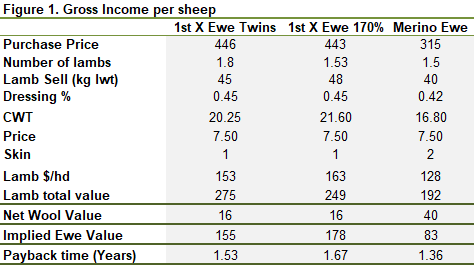Last week saw a new online record set on Auctionsplus of $446/head for some scanned in-lamb first cross ewes. The rise in breeder prices is no doubt in response to abundant feed in destocked areas, here we’ll take a look at how we might justify such a price for ewes.
It wasn’t just one lot that made what is historically extraordinary money. Plenty of 1st cross ewes are making around $400/head, while other breeds, including Merino’s, are making $250-350/head as long as they are scanned in lamb or station mated.
The record mob of sheep scanned as all multiples, which is why they managed to beat a couple of mobs that scanned at 170% (assuming all multiples were twins), but only by $3 per head. The ram of choice for the very expensive ewes appears to be White Suffolk.
The record ewes are due to lamb in the second week of July and were shorn in November, so would be likely shorn again in November, cutting a net $16 per head (3.5kgs clean at 450¢) at current prices.
If we assume a very good lamb survival rate of 90%, each ewe will produce 1.8 lambs. At good growth rates, lambs will reach trade weights of 45-50kgs by late November. At a price of 7.50¢/kg cwt, lambs will make $153/head and the ewes will produce $275 worth of lambs.
After the gross income from lambs and wool, after six months buyers end up with a ewe which has cost $147, plus all the costs associated with getting it to the end of the year.
Figure 1 shows the calculations for the record price ewes. We have also run the same analysis for first cross ewes which scanned 170%, and twinning Merino ewes joined to white suffolks. The Merino ewes were much cheaper and will be expected to produce fewer lambs, but they are likely to owe the buyer the least at the end of the year.
To look at the return on investment, we have to assign the ewes a value at the end of the year, which is extremely difficult. If we put $250 on the first cross ewes, and $180 on the Merinos, returns come in at 21%, 16% and 31% respectively.
What does it mean?
Adding in $60/head in costs, returns still come in positive at 8%, 3% and 12%. However, there are a number of variables that could change and see the trade go sour. At a lamb price of 600¢, and all else steady, first cross ewes will be pushed into negative territory after the $60 of costs, and the Merino ewes break even.
These numbers explain how buyers with plenty of grass can justify paying record money for ewes to restock. Much relies on continued strong lamb prices and lamb demand will have to improve from current levels to make buying expensive ewes profitable.
Have any questions or comments?
Key Points
- Record prices have been paid for breeding ewes recently, with 1st Cross ewes the strongest.
- At good lamb prices, spending over $400 on ewes with multiples should be profitable.
- There is plenty of risk if lamb prices decline during spring and summer.
Click on table to expand
Data sources: MLA | Mecardo












